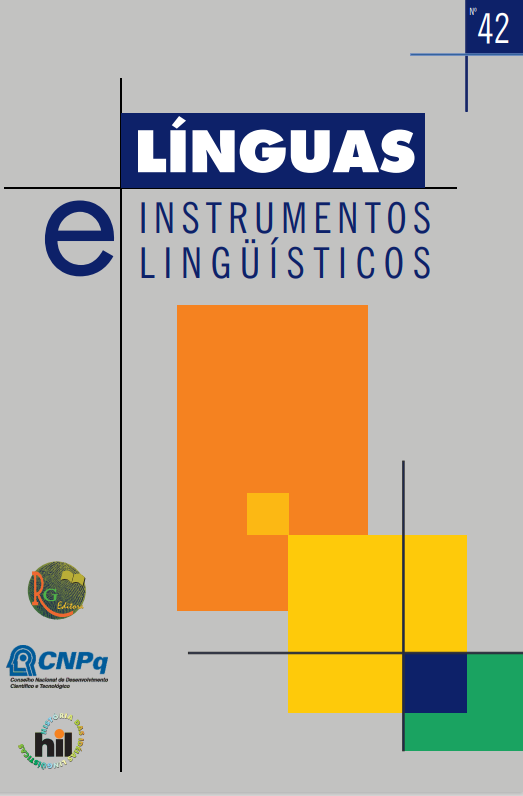Abstract
Based on Abreu (1997) and Hopper and Traugott (1997), the objective of this work is to present an analysis of the degree of integration of the conformative clauses, traditionally recognized as adverbial subordination structures. The few information about the subject indicates the need for a more detailed analysis on the issue. In the light of Usage-Based Functional Linguistics, a set of formal factors was used for the analysis of conformative clauses, based on data from synchronic Brazilian Portuguese. We have confirmed that these sentences present more features of parataxis than hypotaxis. Thus, we conclude that conformative clauses are improperly allocated in the field of adverbial subordination, as has been advocated by grammatical tradition.
References
ALMEIDA, N. M. (1964). Gramática Metódica da Língua Portuguesa. 32. ed. São Paulo: Saraiva.
BARRETO, T. (1999). Gramaticalização das Conjunções na História do Português. Tese. Doutorado em Linguística. Salvador: Universidade Federal da Bahia.
BECHARA, E. (2009). Moderna Gramática Portuguesa. 37. ed. atual. Rio de Janeiro: Nova Fronteira, Lucerna.
BEZERRA, R. (2010). Nova Gramática da Língua Portuguesa para Concursos. 4. ed. Rio de Janeiro: Forense; São Paulo: Método.
BYBEE, Joan (2003). “Mechanisms of change in grammaticization: the role of frequency”. In: JOSEPH, B. D.; JANDA, R. D. In: The handbook of historical linguistics. Malden: Blackwell Publishing, p.624-647.
CAMACHO, R. G. (2011). “A classe de palavras na perspectiva funcional”. In: ______. (Org.) Classe de Palavras na Perspectiva da Gramática Discursivo-Funcional: o papel da nominalização no continuum categorial. São Paulo: Editora da Unesp, p.29-51.
CARVALHO, C. S. (2004). “Processos sintáticos de articulação de orações: algumas abordagens funcionalistas”. In: Veredas, v. 8, n. 1 e n. 2, p.9-27.
CIPRO NETO, P.; INFANTE, U. (1998). Gramática da língua portuguesa. São Paulo: Scipione.
CROFT, W. (1990). Typology and Universals. Cambrigde, United Kingdon: CUP.
CUNHA, M. A. F.; BISPO, E. B.; SILVA, J. R. (2013). “Linguística funcional centrada no uso: conceitos básicos e categorias analíticas”.
In: CEZARIO, M. M; CUNHA, M. A. F. (Orgs.). Linguística centrada no uso: uma homenagem a Mário Martelotta. Rio de Janeiro: Mauad X, FAPERJ, p.13-39.
CUNHA, M. A. F.; TAVARES, M. A. (2007). “Linguística funcional e ensino de gramática”. In: CUNHA, M. A. F.; TAVARES, M. A. Funcionalismo e ensino de gramática. Natal: Editora da UFRN, p.13-51.
DIK, S. (1989). The Theory of Functional Grammar. Dordrecht: Foris.
GIVÓN, T. (1984). Syntax: a functional-typological introduction. Amsterdam: John Benjamins, 2 v.
HAIMAN, J.; THOMPSON, S. A. (1984). “Subordination in universal grammar”. In: Annual Meeting of Berkeley Linguistics Society. 10. Berkeley: Berkeley Linguistics Society.
HOPPER, P.; TRAUGOTT, E. (1997). Grammaticalization. Cambridge: Cambridge University Press.
HOUAISS, A. (2016). Dicionário Houaiss da Língua Portuguesa. 1CD.
KURY, A. G. (1978). Gramática Fundamental da Língua Portuguesa. São Paulo: LISA.
LUFT, C. P. (1988). Gramática Resumida: explicação da Nomenclatura Gramatical Brasileira. Rio de Janeiro: Editora Globo.
MARTELOTTA, M. E. (2011). Mudança Linguística: uma abordagem baseada no uso. São Paulo: Cortez.
MARTINO, A.; LENZA, P. (2013). Português Esquematizado: gramática, interpretação de texto, redação oficial, redação discursiva. 2. ed. rev. São Paulo: Saraiva.
MATEUS, M. H. M. et al. (2003). Gramática da Língua Portuguesa. Lisboa: Caminho.
NEVES, M. H. M. (2011). Gramática de Usos do Português. 2. ed. atual. São Paulo: Unesp.
OLIVEIRA, Mariangela Rios; VOTRE, Sebastião Josué (2009). “A trajetória das concepções de discurso e de gramática na perspectiva funcionalista”. In: Matraga, v. 16, Rio de Janeiro, n. 24, p. 97-114.
PASCOALE, C. N.; INFANTE, U. (1998). Gramática de Língua Portuguesa. São Paulo: Scipione.
ROCHA LIMA, C. H. (1972). Gramática normativa da língua portuguesa. Rio de Janeiro: Livraria José Olympio Editora.
ROSÁRIO, I. C. (2007). Aspectos sintáticos e semânticos do como na linguagem padrão contemporânea. Dissertação. Mestrado em Letras Vernáculas (Língua Portuguesa). Rio de Janeiro: Universidade Federal do Rio de Janeiro. _____ (2012). Construções Correlatas Aditivas em Perspectiva Funcional. Tese. Doutorado em Letras. Niterói - RJ: Universidade Federal Fluminense. _____ (2016). “Reflexões sobre o critério da (in)dependência no âmbito da integração de orações”. In: Línguas & Letras, v. 17, n. 35, p.252-272. _____; OLIVEIRA, M. R. (2016). “Funcionalismo e Abordagem Construcional da Gramática”. In: Alfa, São Paulo, 60 (2), p.233-259.
TAYLOR, J. R. (1995). Linguistic Categorization. 2. ed. Oxford: Oxford University Press. TROUSDALE, G. (2008). “Words and constructions in grammaticalization: The end of the English impersonal construction”.
In: FITZMAURICE, S. M.; MINKOVA, D. (Orgs.). Studies in the History of the English Language IV. Berlin, New York (Mouton de Gruyter), p.301-326.
WIEDEMER, M. L.; ROSÁRIO, I. C. (2014). “Língua em uso: gramática, discurso e construções”. In: Revista Soletras, n. 28, p.1-11.

This work is licensed under a Creative Commons Attribution-NonCommercial-ShareAlike 4.0 International License.
Copyright (c) 2020 Línguas e Instrumentos Línguísticos


